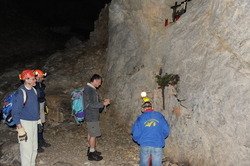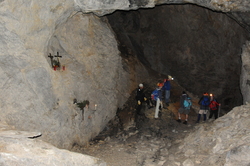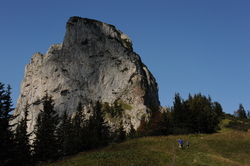Frauenmauerhöhle
Frauenmauer-Langstein-System
Useful Information




| Location: |
NE of Eisenerz.
From Eisenerz road to Präbichl Paß (1,227 m asl), cable car to Polster (1,911 m asl),
2:45 walk to east entrance.
From Gsollkurve (Gsoll curve) on road to Präbichl 2 hours walk to west entrance.
Kat-Nr. 1742/1 (47.5645561, 14.9688277) |
| Open: |
JUN to 15-SEP daily. Eastern entrance: 10, 12, 14. Western entrance: 9, 11, 13. Gsollalm: 15-JUN to 15-SEP Mon-Fri 13-19, Sat, Sun, Hol 9-19. [2009] |
| Fee: |
. [2025] |
| Classification: |
 Karst Cave.
Wettersteinkalk, Middle Triassic (Ladinian) Karst Cave.
Wettersteinkalk, Middle Triassic (Ladinian)
|
| Light: | none, bring torch. |
| Dimension: | L=20,215 m, VR=595 m. |
| Guided tours: | L=644 m, VR=125 m. West entrance 1,435 m asl. East entrance 1,560 m asl. |
| Photography: | allowed |
| Accessibility: | no |
| Bibliography: |
Hans Hofmann-Montanus, Ernst Felix Petritsch (1952):
Die Welt ohne Licht,
Höhlenforscher und Höhlengänger in Tragödien und Abenteuern.
Regensburg, Verlag Josef Habbel, 1952.
418 S. m. zahlr. Abb., s/w-Fotogr. auf Tafeln u. 2 Faltkarten.

Norbert Casteret (1955): The Darkness Under the Earth, New York Henry Holt 1955. 1st Ed. U.S., 9 Photos & 1 Map. |
| Address: | Höhlenführer Rudolf Krenn, Werner Hofer, Flutergasse 45, 8790 Eisenerz, Tel: +43-3848-2827 (Krenn), 03848-3672 (Hofer). |
| As far as we know this information was accurate when it was published (see years in brackets), but may have changed since then. Please check rates and details directly with the companies in question if you need more recent info. |
|
History
| 1820 | exploration by miners from Eisenerz. |
| 1834 | first cave map. |
| 20-JUL-1928 | Franz Rathschüler died in the cave. |
| 1928-1930 | surveyed by J. Gangl and S. Ausobsky, two members of the Landesverein für Höhlenkunde in der Steiermark. |
| 26-SEP-1929 | Franz Rathschüler found by J. Gangl and S. Ausobsky. |
| 1930 | three tourists got lost in the cave without light died. |
| 1930 | first explorations in the Langstein-Tropfsteinhöhle (Langstein Dripstone Cave). |
| 1931 | declared a Naturdenkmal (natural monument). |
| 1931 | Walpurgisdom discovered. |
| 1961 | Cavers from Eisenerz discover the connection between the Frauenmauerhöhle and the Langsteinhöhle. |
| 1970 | new discoveries increase the known length to 11.5 km. |
| 1982 | continuous discoveries increase the length to 21 km. |
Description




The Frauenmauerhöhle is a 640 m long passage leading through the whole mountain called Frauenmauer. It has several rooms and passages on both sides, one of the most interesting is the ice chamber just a view steps from the west entrance lefthand side.
Altough this cave is not really difficult, it is very dangerous to get lost without light inside a cave, and so several lethal accidents happened in this cave. The dead are good arguments for the certified cave guide who does cave tours today. So this cave is a sort of semi-wild show cave, as it is not developed in any way, but it is guided like a show cave.
The most famous accident in this cave is probably the death of Franz Rathschüler. He was principal of a secondary school in Salzburg and was walking in the Austrian Alps in his holidays. He followed the cave description in a famous and renowned guide book, the Baedeker Südbayern, Tirol, Salzburg, which had an ambiguous formulation on page 552. So he took the wrong passage and fell down a shaft, too deep to get out without help. He wrote his last thoughts into his diary, which was found more than a year later.
Only one year later, a group of three tourists with poor light were trapped in the cave. When the light went out they followed the cave wall to get out of the cave, now and then igniting a match, the last light source they had left. This is normally a good idea, but this cave has a so-called circle passage, which simply means the passage bifurcates, and following the wall of the huge pillar in the middle means that you make circles indefinitely. A good idea would have been to change to the opposite wall, after they did not reach the exit after some time. But as they could not see, they did not notice that they were going the same passage on and on. They were found after weeks, the legend tells only skeletons were found and burnt matches along the wall of the pillar. Today a set of crucifixes marks the place.
This classical part of the cave, a 640 m long through passage, is only a small part of the cave system. It is the longest cave system in the Hochschwab massive and more than 21 km long. The whole system is called Frauenmauer-Langstein-Cave-System, as those two caves were originally explored independently. It has seven entrances all over the mountain range and covers an area of 1.2 km from east to west and 1.5 km from north to south. Many parts are really huge, especially the area around the Walpurgisdom. The cave has a passage pointing to nearby Langstein-Eishöhle (Langstein Ice Cave), but a connection has not yet been discovered.









 Search DuckDuckGo for "Frauenmauerhöhle"
Search DuckDuckGo for "Frauenmauerhöhle" Google Earth Placemark
Google Earth Placemark OpenStreetMap
OpenStreetMap Frauenmauerhöhle - Wikipedia
Frauenmauerhöhle - Wikipedia  SAGEN.at - SAGE VON DER FRAUENMAUER
SAGEN.at - SAGE VON DER FRAUENMAUER  Index
Index Topics
Topics Hierarchical
Hierarchical Countries
Countries Maps
Maps